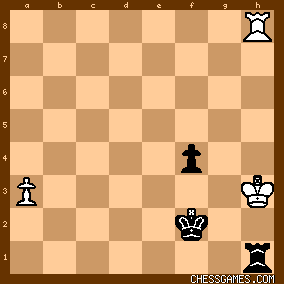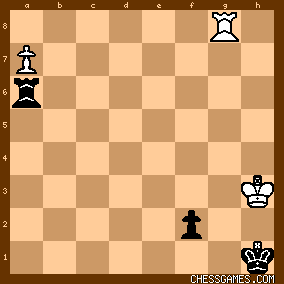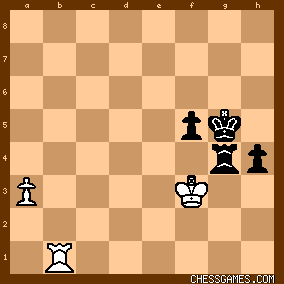|
< Earlier Kibitzing · PAGE 2 OF 2 ·
Later Kibitzing> |
Nov-14-20
 | | OhioChessFan: Pretty lame stalemate try at the end of a brilliant beatdown. Seriously, Kramnik? |
|
| Nov-14-20 | | Muttley101: Thanks <Brenin> I've played a lot of rook and pawn endings, including in sudden death/quickplay finishes. Examples include winning a R+P ending a pawn down against a 2100, and more to the point, knowing when we reached it was lost for me and how white should win it. I studied endgames more than openings as a junior. |
|
| Nov-14-20 | | Messiah: <chrisowen> How do you generate these comments? |
|
| Nov-14-20 | | Muttley101: Thanks <Brenin>. This one is one of the hardest I've seen in recent times (starts at move 39): Caruana vs Carlsen, 2018 But endgames with multiple passed pawns are just crazy. There are a lot of great examples. Karpov winning with his pawns only on one side of the board against Hort is a great technical example. Karpov's rook endings are stellar. Starts at move 27. Karpov vs Hort, 1979 Incidentally, earlier I should have been clearer- for learning point 1, I should have said "activate the king and support advancing passed pawns". Just pushing pawns ain't gonna cut it :D |
|
Nov-14-20
 | | chrisowen: <Messiah> Horse before the cart no? |
|
| Nov-14-20 | | Walter Glattke: Inn a book of Löwenfisch-Smuislov from the 60ies, there are many rook endings and 10 general rules, after I read this I would play in the mysterious move 53 then 53.-Ra2 54.Ra5 h4, so the rook must be behind, the king near to own or enemies pawn, and the king is stronger near, the rook stronger as far-working figure. Try my ending moves here, you can learn more about rook endings, so also Kramnik and Beljavsky should do, at least for this position after 53.Rxb5. |
|
| Nov-14-20 | | thegoodanarchist: As so often happens at this level, a deep and complicated combination leads only to the win of a pawn. |
|
| Nov-14-20 | | thegoodanarchist: <FSR: <Eduardo Bermudez> Only eight? By my count he's beaten Smyslov, Tal, Petrosian, Spassky, Karpov, Kasparov, Kramnik, Anand, and Khalifman at classical time controls, and Ponomariov in rapid games. That's ten, or nine if you only count classical games.> Instead of only counting classical, what if you don't count Khalifman? His WC title was only achieved due to a rather farcical decision by FIDE. |
|
| Nov-14-20 | | King.Arthur.Brazil: I guess that Black could play: 24...♗xh2+, then:
A. 25. ♔xh2 ♖xf2 26.♘g5 h6, or
B. 25. ♔f1 ♖c2, since White cannot answer 26. ♗xg7+? ♔xg7 27. ♘xh2 ♖fxf2+. So, after 26. ♖ac1 ♖xc1 27. ♖xc1 ♗g3 and Black is 2♙ ahead.
Next, White could answer 30.♖e1 (Black would not move 30...♗d7? 31.♗d4!) 30...Re7 31. Bd4 Nf5 32. Rxe7 Bxe7 33. Bxa7 b6 34. Bb8 Bd6 35. Ne4 . I feel White has drawing chances. Therefore 30.♗d4 seems premature. Losing this opportunity, White game kept inferior. Also 34.♗xf6? is a strategical mistake. Obviously, it is impossible 45. ♘xf6?? ♔e7... wins the ♘. I'm certain that Black complicated his game risking to draw. After, 61.♖b1 ♖xa3 It could follow: 62. ♖b4+ f4 63. ♖b8 ♖a2+ 64. ♔f1 ♔g3 and White are in zugswang:
C.65.♖b3+ f3 66. ♖b1 ♖h2 67. ♔g1 f2+ 68. ♔f1 ♖h1+ win the ♖ or
D.65. ♖g8+ ♔f3 66. ♔g1 h3 67. ♖h8 ♖a1+ 68. ♔h2 ♔f2 69. ♖xh3 f3 70. ♖h8 ♖e1 71. ♖f8 ♖e2 72. ♔h1 ♖e3 73. ♔h2 ♔e1 74. ♔g3 f2+ 75. ♔g2 ♖e2 76. ♔h1 ♖e7 77. ♔g2 ♖g7+ 78. ♔h1 f1=♕+ End. |
|
| Nov-14-20 | | stacase: <Messiah: <chrisowen> How do you generate these comments?> Not mine to answer, but it is fairly easy in Microsoft's Excel to generate nonsense random strings of letters, numbers, symbols, and words as a way to generate passwords. Useful formulas in Excel are =rand() and =VLOOKUP(), combine results using =[...]&[...]&[...] etc. |
|
| Nov-14-20 | | devere: Nice combination to win a pawn, but the rook ending was a tablebase draw up to move 59 https://syzygy-tables.info/?fen=8/8... |
|
Nov-14-20
 | | chrisowen: No sap front it is ... |
|
Nov-14-20
 | | Jimfromprovidence: <al wazir> <And why didn't white play 68. Rxh3 ?> I am thinking that 68...f3, below, seeing 69...Ke2 looks really good for black. 
click for larger viewI think that wins no matter where white moves his rook or whether he plays 69 a4. |
|
| Nov-14-20 | | Everett: Saw all the way to White’s 81st |
|
Nov-15-20
 | | al wazir: <Muttley101>: Thanks very much for your detailed answers to my questions. I will ponder them. I assumed that a two-pawn advantage would be an automatic win. It certainly is if the ♖s are off the board, and in some lines black can even give up a ♙ in order to achieve the ♖ swap. I remember my logic professor despairing over the failure of a student to understand his explanation of a point. He said, "I guess there are some people who are just unable to learn logic." Similarly, I may be someone who is unable to learn ending play. |
|
Nov-15-20
 | | al wazir: <Jimfromprovidence: I am thinking that 68...f3, below, seeing 69...Ke2 looks really good for black. All right, I'll buy that. Then how about 68. Kxh3 ? If now 68...f3, then 69. Rf8. I'm not sure what black's plan should be. If 69...Rd3, then 70. a4. Now the black ♔ is blocking the remaining ♙ and can't defend it if it moves: 70...Ke2 71. Kg3 f2+ 72. Kg2. Or 69...Rh1+ 70. Kg4 Rg1+ 71. Kf4 Kg2 72. Rg8+ Kh2 73. h8+ Kg2 74. Rg8+, etc. |
|
| Nov-15-20 | | saturn2: What happens after 73.Kxh3? |
|
Nov-15-20
 | | Jimfromprovidence: <al wazir> <All right, I'll buy that. Then how about 68. Kxh3 ?> Simple. If 68 Kxh3, then 68...Rh1+.

click for larger view |
|
Nov-15-20
 | | Jimfromprovidence: <saturn2> <What happens after 73.Kxh3?> This one is a lot trickier. Here is the position. 
click for larger viewOne way to win is to first move the king to clear the promotion square. In this case that means 73...Kg1 (not 73...Ke1??) If black follows with 74 Rg8+ then 74...Kh1. 
click for larger viewThe next step is to drive the king from the f pawn while protecting that pawn. This begins 75 Rf8 Ra3+ 76 Kh4 Kg1 or (Kg2) 77 Rg8+ Kh2 78 Rf8 Ra4+ 79 Kh5. 
click for larger viewBlack keeps employing the same strategy until the white king reaches the 7th rank, then takes the a pawn with check. White cannot now stop the promoting pawn without losing the rook. Of course white can promote his a pawn at any time during this sequence and be down a queen vs. rook ending. |
|
| Nov-15-20 | | saturn2: <Jimfromprovidence
75 Rf8 Ra3+ 76 Kh4 Kg1 or (Kg2) 77 Rg8+ Kh2 78 Rf8 Ra4+ 79 Kh5. Black keeps employing the same strategy until the white king reaches the 7th rank, then takes the a pawn with check.> Many thx for your answer. In your method I dont see how the white king will be forced to the 7th rank. Let us say the white king is already on h5. If black plays Ra5+ cannot the white king move to h4 again? What I saw like you when I put my original answer is that promoting a8Q does not save white. Black takes Rxa8, Rxa8 f1Q+ and the rook on a8 will somehow fall after the black queen forking whitr's queen and rook. |
|
Nov-15-20
 | | Jimfromprovidence: <saturn2> <Many thx for your answer. In your method I dont see how the white king will be forced to the 7th rank. Let us say the white king is already on h5. If black plays Ra5+ cannot the white king move to h4 again?> No, because black will move his king to h3 first. So after 79 Kh5 in the previous line black can play 79...Kg2 (or Kg3) . Now if 80 Rg8+ then 80...Kh3, etc. 
click for larger view |
|
Nov-15-20
 | | al wazir: <Jimfromprovidence: Simple. If 68 Kxh3, then 68...Rh1+. > Of course. I've got to stop asking questions. |
|
| Nov-16-20 | | saturn2: <Jimfromprovidence> Thx again, now I got it and write down the full moves.
73. Kxh3 Kg1 74. Rg8+ Kh1 75. Rf8 Ra3+ 76. Kh4 K-
g2 77. Rg8+ Kh2 78. Rf8 Ra4+ 79. Kh5 Kg2 80. Rg8-
+ Kh3 81. Rf8 Ra5+ 82. Kh6 Kg3 83. Rg8+ Kh4 84. -
Rf8 Ra6+ 85. Kh7 Rxa7+
The only remark I have to make is that the Q vs R ending after 84. a8=Q Rxa8 85. Rxa8 f1=Q
is more challenging when the white king is not on h3 and f1Q is no check. |
|
| Nov-17-20 | | saturn2: Above white can also play 83. Kg6 but then simply Ra1 wins. The stunning thing about <Jimfromprovidence>'s nethod of pushing the white king back is that it does not work ad infinitum. But the 7th rank isTHE LAST rank black could push back the white king. Such a thight thing. |
|
Nov-17-20
 | | g15713: E. 1.0
Black to move at 53

click for larger viewSyzygy says this is a draw at this point
'https://syzygy-tables.info/?fen=8/8... Game continued:
53...f5 54. Rb1 h4 55. Ke3 Rg2 56. Kf3 Rg3+ 57. Kf4 Rg4+ 58. Kf3 Kg5 E. 1.1
White to move at 59

click for larger viewSyzygy says this is a draw by White playing
59. a4 or Rb6 or Rb7 or Rb8 or Rc1 draws while 59. Ra1 loses 'https://syzygy-tables.info/?fen=8/8... |
|
 |
|
< Earlier Kibitzing · PAGE 2 OF 2 ·
Later Kibitzing> |





